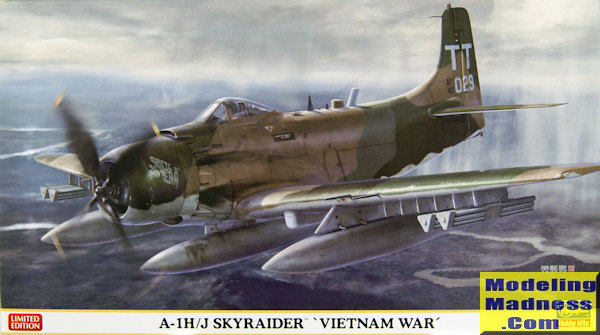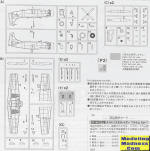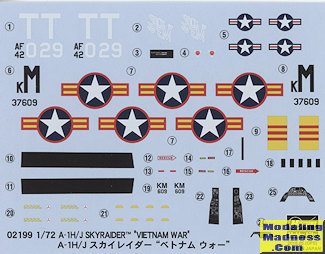
| KIT #: | 02199 |
| PRICE: | 2700 yen (about $26 at current exchange rates) plus shipping from Japan |
| DECALS: | Two options |
| REVIEWER: | Scott Van Aken |
| NOTES: | 2016 Limited Edition |

| HISTORY |
As American involvement in the Vietnam War began, the A-1 Skyraider was still the medium attack aircraft in many carrier air wings, although it was planned to be replaced by the A-6A Intruder as part of the general switch to jet aircraft. Skyraiders from Constellation and Ticonderoga participated in the first U.S. Navy strikes against North Vietnam on 5 August 1964 as part of Operation Pierce Arrow in response to the Gulf of Tonkin Incident, striking against fuel depots at Vinh, with one Skyraider from Ticonderoga damaged by anti-aircraft fire, and a second from Constellation shot down, killing its pilot.
During the war, U.S. Navy Skyraiders shot down two North Vietnamese Air Force (NVAF) Mikoyan-Gurevich MiG-17 jet fighters: one on 20 June 1965, a victory shared by Lieutenant Clinton B. Johnson and Lieutenant, junior grade Charles W. Hartman III of VA-25; and one on 9 October 1966 by LTJG William T. Patton of VA-176. Using their cannons, this was the first gun kill of Vietnam.
As they were released from U.S. Navy service, Skyraiders were introduced into the South Vietnamese Air Force (VNAF). They were also used by the USAF to perform one of the Skyraider's most famous roles: the "Sandy" helicopter escort on combat rescues. USAF Major Bernard F. Fisher piloted an A-1E on 10 March 1966 mission for which he was awarded the Medal of Honor for rescuing Major "Jump" Myers at A Shau Special Forces Camp. USAF Colonel William A. Jones, III piloted an A-1H on 1 September 1968 mission for which he was awarded the Medal of Honor. In that mission, despite damage to his aircraft and suffering serious burns, he returned to his base and reported the position of a downed U.S. airman.
After November 1972, all A-1s in U.S. service in Southeast Asia were transferred to the South Vietnamese Air Force (VNAF) and their roles taken over by the subsonic LTV A-7 Corsair II. The Skyraider in Vietnam pioneered the concept of tough, survivable aircraft with long loiter times and large ordnance loads. The USAF lost 201 Skyraiders to all causes in Southeast Asia, while the Navy lost 65 to all causes. Of the 266 lost A-1s, five were shot down by surface-to-air missiles (SAMs), and three were shot down in air-to-air combat; two by North Vietnamese MiG-17s.
On the night of 29 August 1964, the first A-1E Skyraider was shot down and the pilot killed near Bien Hoa Air Base; it was flown by Capt. Richard D. Goss from the 1st Air Commando Squadron, 34th Tactical Group. The second A-1 was shot down on 29 April 1966, and the third A-1, Pilot Capt. Grant N. Tabor, was lost on 19 April 1967; both were from the 602 Air Commando Squadron (ACS). The fourth A-1 Skyraider was from Navy Squadron VA-25 flying a ferry flight from Cubi Point (Philippines) to Coral Sea and was lost to two Chinese MiG-17 on 14 February 1968. Lieutenant (j.g.) Joseph P. Dunn, USN, had flown too close to the Chinese held island of Hainan, and had been intercepted. Lieutenant Dunn's A-1H Skyraider 134499 (Canasta 404) was the last U.S. Navy A-1 lost in the war. He was observed to survive the ejection and deploy his raft, but was never found. Initially listed as MIA, he is now listed as KIA and posthumously promoted to the rank of Commander. Shortly thereafter, A-1 Skyraider naval squadrons transitioned to the A-6 Intruder, A-7 Corsair II or Douglas A-4 Skyhawk.
In contrast to the Korean War, fought a decade earlier, the U.S. Air Force used the naval A-1 Skyraider for the first time in Vietnam. As the Vietnam War progressed, USAF A-1s were painted in camouflage, while USN A-1 Skyraiders were gray/white in color; again, in contrast to the Korean War, when A-1s were painted dark blue.
In October 1965, to highlight the dropping of the six millionth pound of ordnance, Commander Clarence J. Stoddard of Attack Squadron 25 (VA-25), flying an A-1H, dropped a special, one-time-only object in addition to his other munitions – a toilet (see photo).
| THE KIT |
 Hasegawa
has done several boxings of this kit and offered it in both USN and USAF
aircraft. For the most part, the sprues have been the same for all the different
boxings. The kit provides a basic tub with seat, stick and instrument panel with
decals for instruments. Behind the seat is a canvas covered assembly. Now I
don't know if this is for the Yankee extraction system or not, but until late in
their USN career, the plane did not have this installation. USAF planes,
however, soon had this installed as part of the USAF modifications.
Hasegawa
has done several boxings of this kit and offered it in both USN and USAF
aircraft. For the most part, the sprues have been the same for all the different
boxings. The kit provides a basic tub with seat, stick and instrument panel with
decals for instruments. Behind the seat is a canvas covered assembly. Now I
don't know if this is for the Yankee extraction system or not, but until late in
their USN career, the plane did not have this installation. USAF planes,
however, soon had this installed as part of the USAF modifications.  s,
four six shot rocket pods and two WWII era bombs. It means a lot of empty pylons
so you might want to grab bits from your spares box or weapons sets if you want
more. The toilet is included on the bomb sprue.
s,
four six shot rocket pods and two WWII era bombs. It means a lot of empty pylons
so you might want to grab bits from your spares box or weapons sets if you want
more. The toilet is included on the bomb sprue. | REFERENCES |
| REFERENCES |
https://en.wikipedia.org/wiki/Douglas_A-1_Skyraider
June 2016
If you would like your product reviewed fairly and fairly quickly, please contact the editor or see other details in the Note to Contributors.